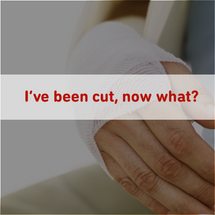Posted by Staff on 5th Apr 2017
I've been cut, now what?
StatGear prides itself in preparation. We strive to make innovative and useful products in the event of an emergency, and want you to always be prepared should the need arise.
We’ve all been cut before. Whether it was from cooking, a mishap, or a freak of nature accident, knowing how to properly clean a cut or wound is extremely important. No one wants an infection, and for those cuts that are really bad, one should know how to properly care to their wound if medical help isn’t nearby.
Disclaimer: This article should not be taken as an alternative to licensed medical advice. Always consult professional medical advice if you have questions or need medical help.
You’re cut, now what? Consider these steps:
1. Your environment
Where are you? Nature, at home? An important first step is to consider your environment, and act accordingly. If you’re in a place that’s very dirty, vs. a cleaner environment like the indoors, your plan of action will be different. A dirty wound can increase your likelihood of infection, so step one is clean your wound.
2. What type of cut do I have?
Is the cut small, is it a deep laceration?
3. Are there any foreign objects in my cut?
Do you have a splinter, or something larger like a piece of glass or metal? This is important, because any foreign debris can increase your likelihood of infection. Remembering this step is crucial.
4. Can’t properly asses your injury? Irrigate your cut
If you’re bleeding to the point where it’s difficult to assess what’s going on, lightly irrigate your wound. This can be done with flushing water on it, using a saline solution, or even a mild soap. Once you have a better idea of what’s going on, you’ll have a clearer idea of the next step.
If after irrigating, you’ve found that you have a foreign object in your wound, remove it only if it’s safe to. If so, irrigate it with clean water, or a saline solution. If you’ve found that you have something like a wood splinter, use tweezers (sterilize them first with rubbing alcohol), and attempt to dislodge it. For any object that’s more serious and that you’re unable to remove, apply pressure and elevate the wound. Seek medical attention, and do not seal your wound if you’re unable to decontaminate and remove it.
5. Sterilize & seal your wound.
After you’ve cleaned your cut or wound, sterilize it with a saline solution, rubbing alcohol, or mild soap. Seal the wound with a bandaid, or in a bind, super glue or duct tape. If you’re caught in a bind and have a more serious wound, tie a t-shirt or any other type of material you may have around your wound. This will both apply pressure and help keep it closed until you’ve sought medical attention.
Now what?
Keep an eye on things. If at any point you notice the wound or surrounding area excreting pus, (white or yellow liquid), you most likely have an infection. At this point, seek medical attention to assess the severity of your injury. This is vital as some infections are extremely dangerous, and can sometimes lead to death.
To recap, irrigate your wound with saline solution or water, sterilize with an antiseptic like rubbing alcohol, apply pressure, and seal your wound.
Do not try to remove any objects with dirty hands, as this can increase your chance of infection. If you notice any foreign objects in your cut, remove them if it’s safe, and seal your wound if you’re able to get it out. Otherwise, do not seal your wound, as it can become infected.
We’ve put together different kits to assist with these types of injuriesz. We offer an auto survival kit, auto first aid kit, and a deluxe travel first aid kit. Each kit has the necessary things to aid in the event you become cut.
As always seek medical attention / advice if you have any questions.
Stay safe!

